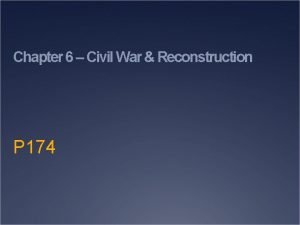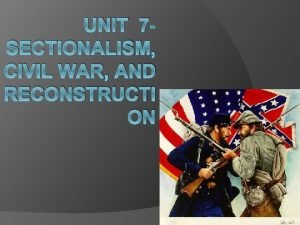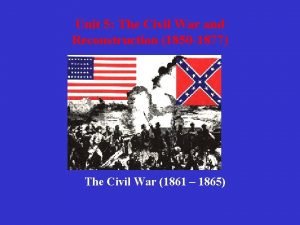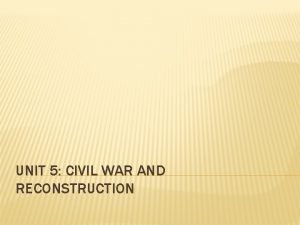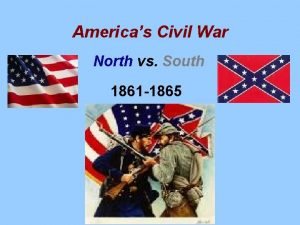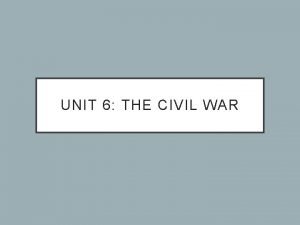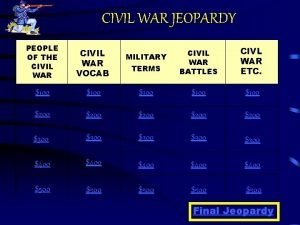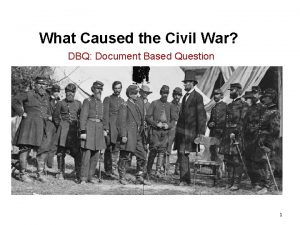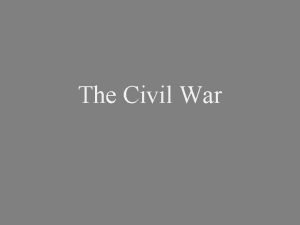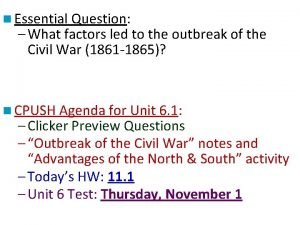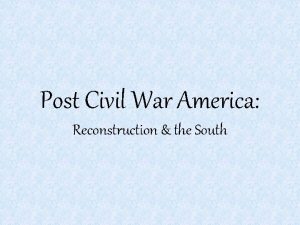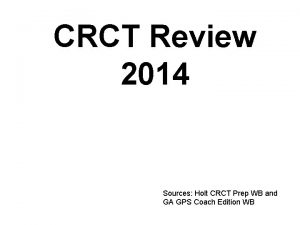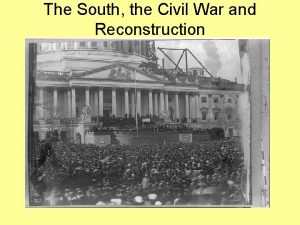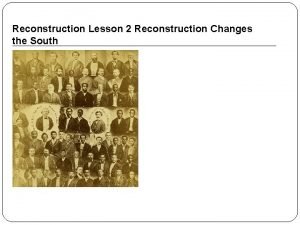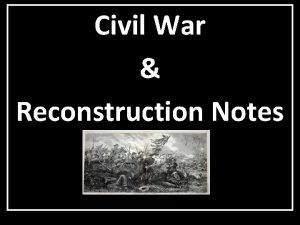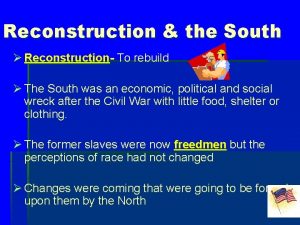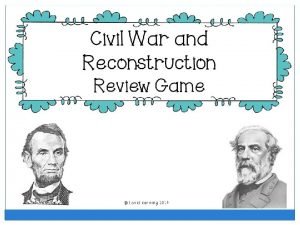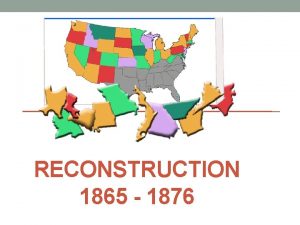Civil War Reconstruction New South CRCT REVIEW UNITS































- Slides: 31

Civil War Reconstruction New South CRCT REVIEW UNITS 4 AND 5

UNIT 4: CIVIL WAR AND RECONSTRUCTION Standards and Elements: SS 8 H 5 • SS 8 H 6 • SS 8 E 1 • SS 8 E 2 (a. ) •

CAUSES OF THE CIVIL WAR Slavery – The economy of southern states was based on agriculture (farming mainly of crops such as cotton). Slaves were thought to be a “necessary evil” in helping with the growing of crops. States’ Rights - Belief that the state’s interests take precedence over interests of national government. Southern states believed they had the right to govern themselves and decide what would be best for their own situation (one example would be the issue of slavery).

CAUSES OF THE CIVIL WAR Nullification – The Tariff of 1828 tried to protect northern factories from competition by forcing the south to pay additional taxes on products purchased from England. The south believed in nullification (the idea that they have the right not to follow a federal law). Missouri Compromise – Missouri entered the U. S. as a slave state and Maine entered as a free state in 1820. Outlawed slavery north of 36° 20' latitude (the southern border of Missouri), and included Louisiana Territory lands west of Missouri Compromise of 1850 – California enters the U. S. as a free state. Also included the Fugitive Slave Act which required northern states to return runaway slaves to the south.

CAUSES OF THE CIVIL WAR Georgia Platform – The North would support the Fugitive Slave Act and not ban slavery in new states in order to uphold the Compromise of 1850. Georgia was credited with preventing war and secession. Kansas-Nebraska Act - Created the territories of Kansas and Nebraska. Those territories had right of popular sovereignty and could decide whether or not to allow slavery. Dred Scott – Supreme Court case in 1857 Court ruled that slaves were not citizens and could not file lawsuits. Also, the Supreme Court ruled that Congress could not stop slavery in the territories.

CAUSES OF THE CIVIL WAR Election of 1860 – Republican Party had formed after the Dred Scott case. It took an anti-slavery position. Abraham Lincoln, the Republican candidate, won the election of 1860 and became the American President. Secession – Alexander Stephens, one of GA’s representatives in Congress, called for the south to remain loyal to the Union and voted against secession. Following many debates over what Georgia should do, Georgia decided to secede from the Union on January 21, 1861.

CAUSES OF THE CIVIL WAR VIDEO Brain. Pop – Civil War Causes YMS Brain. Pop Login Information: Username: wcyms Password: yms

UNIT 4: CIVIL WAR AND RECONSTRUCTION I. Antebellum Georgia 1. 2. 3. 4. 5. 6. 7. 8. 9. 10. Missouri Compromise Georgia Platform Kansas/Nebraska Act Secession Alexander Stephens Compromise of 1850 Republican Party States’ rights Slavery abolitionists Nullification 12. Dred Scott 13. Abraham Lincoln 14. Industry/Factories 15. Cotton 11.

KEY EVENTS OF THE CIVIL WAR Antietam - Sept. 17, 1862. Bloodiest single day of the Civil War. Union Army defeated the Confederate Army (under the leadership of Robert E. Lee). About 2, 000 Northerners and 2, 700 Southerners were killed and 19, 000 people were wounded. Emancipation Proclamation – Issued by Abraham Lincoln. Stated that all slaves in any states in rebellion against the Union would become free on January 1, 1863.

KEY EVENTS OF THE CIVIL WAR Gettysburg - July 1 to July 3, 1863. Union Army defeats the Confederates. Union suffers 23, 000 Causalities (dead and wounded soldiers). Confederacy suffers 28, 000 casualities Chickamauga – September 1863. Union troops were driven back to Chattanooga; Confederates did not follow-up on their victory. Union reinforcements later recaptured Chattanooga. Union Blockade of GA’s Coast – The Union used naval ships to prevent the south from continuing to trade materials (such as cotton) with the British. Kept the south from having the materials necessary to continue to fight.

KEY EVENTS OF THE CIVIL WAR Atlanta Campaign – William Tecumseh Sherman forced the confederate soldiers and citizens of Atlanta to retreat out of the city. His soldiers then proceeded to burn 90% of Atlanta. The March to the Sea - Part of the Lay Waste Strategy Sherman’s Union army destroys everything in its path, 300 miles from Atlanta to Savannah. A sixty mile-wide area is burned, destroyed, and ruined during a two-month period. Captured Savannah in 1864.

KEY EVENTS OF THE CIVIL WAR Andersonville Prison, in southwest Georgia, was overcrowded, and offered poor food, contaminated water, and poor sanitation; 13, 700 Union soldiers are buried there. General Robert E. Lee’s Army of Virginia cannot defeat Union General Ulysses S. Grant at Petersburg; he surrenders his army at Appomattox Courthouse on April 9, 1865. The Civil War was over. 620, 000 people died during the war; about two-thirds died from diseases, wounds, or military prison hardships.

CIVIL WAR VIDEO Brain. Pop – Civil War YMS Brain. Pop Login Information: Username: wcyms Password: yms

UNIT 4. CIVIL WAR AND RECONSTRUCTION II. Civil War 11. Naval blockade 12. Emancipation Proclamation 13. Antietam 14. Robert E. Lee 15. William T. Sherman 16. Andersonville 17. Chickamauga 18. Gettysburg

RECONSTRUCTION After the Civil War the Union had to be reconstructed (bringing the north and south back together again). Freedmen’s Bureau – Set up to assist freed slaves. Assisted them with food, clothing, shelter, education, and with getting jobs. Many freed slaves became sharecroppers or tenant farmers. Sharecropping was a farming method in which a land owner loans farmers housing, seeds, and tools in return for part of the crop’s profits. Tenant farming was a similar system except the tenant farmer would provide their own seeds and tools and only rented land.

CHANGES IN GOVERNMENT 13 th Amendment – Outlawed slavery. 14 th Amendment – Granted citizenship to freedmen and required “equal protection under the law” for all freed slaves. 15 th Amendment – Gave all males the right to vote regardless of race. Due to these amendments, African Americans (Henry Mc. Neal Turner and other black legislators) won elections in Georgia for the first time.

KU KLUX KLAN Secret organization – originally started as a social club for men returning from the war. Members hid behind robes and masks. The group terrorized blacks to keep them from voting.

UNIT 4. CIVIL WAR AND RECONSTRUCTION III. Reconstruction Sharecropping 17. Tenant farming 19. Lincoln’s plan 20. Johnson’s plan 21. Congressional plan 22. 16. 23. 24. 25. 26. 27. 28. Freedman’s Bureau 13 th amendment Henry Mc. Neal Turner Reconstruction 14 th Amendment Ku Klux Klan 15 th Amendment

UNIT 5: THE NEW SOUTH Standards and Elements: SS 8 H 7 • SS 8 E 3 •

GEORGIA IN A NEW SOUTH Bourbon Triumvirate - Powerful Democratic leaders, known as the “Bourbon Triumvirate” were Joseph E. Brown, Alfred H. Colquitt, and John B. Gordon. Their goals were to expand Georgia’s economy and ties with industries in the North and maintain the tradition of white supremacy. Henry Grady – Father of the New South. Wanted Georgia to advance to an industrial society that could compete with the north while also increasing the technology used in farming. International Cotton Exposition – Designed to show the economic recovery that had taken place in the south by 1895.

GEORGIA IN A NEW SOUTH Tom Watson and the Populists – Worked to protect farmer’s rights while also helping them in their struggle with the “wealthy” people. Rebecca Latimer Felton – Supporter of women’s suffrage (the right to vote). Helped increase social reform for women’s rights. Became the first woman to serve in the U. S. Senate in 1922. 1906 Atlanta Race Riot – String of violence by whites against African Americans over two days in 1906. 21 people were killed and hundreds were wounded.

GEORGIA IN A NEW SOUTH Leo Frank – Accused of killing Mary Phagan. Very little evidence against him but Frank was found guilty and sentenced to death. Frank was taken from the prison and lynched by a group calling themselves the Knights of Mary Phagan. This group later reformed as the KKK. County Unit System - Plan designed to give small counties more power in state government. People could be elected to office without getting a majority of votes. Declared unconstitutional in 1962.

UNIT 5: THE NEW SOUTH I. Economics of the New South 1. 2. 3. 4. 5. Bourbon Triumvirate Populist Party Rebecca Latimer Felton Henry Grady Tom Watson International Cotton Exposition 7. 1906 Atlanta Riot 8. Leo Frank 9. Knights of Mary Phagan 10. County Unit System 11. Coca-Cola 6.

AFRICAN AMERICANS IN THE NEW SOUTH Jim Crow Laws - Laws passed to separate blacks and whites. Plessy v. Ferguson: Supreme Court decision which approved Jim Crow laws – decision in place until 1954 Laws created to keep African Americans in Georgia from voting (disenfranchisement) �Poll tax: a tax paid to vote �Voters had to own property �Voters had to pass a literacy test (which was determined by the poll worker and could be different for different people). �Grandfather clause: only those men whose fathers or grandfathers were eligible to vote in 1867 could vote

CIVIL RIGHTS LEADERS Booker T. Washington - President of Tuskegee Institute in Alabama. Worked to improve the lives of African Americans through economic independence. Believed social and political equality would come with improved economic conditions and education. Delivered the famous “Atlanta Compromise” speech in 1895. W. E. B. Du. Bois - Professor at Atlanta University. Believed in “action” if African Americans and whites were to understand accept each other. Thought Booker T. Washington was too accepting of social injustice.

CIVIL RIGHTS LEADERS John and Lugenia Burns Hope - Civil rights leader from Augusta, GA. President of Atlanta University. Like Du. Bois, believed that African Americans should actively work for equality. Part of group that organized NAACP. Hope’s wife, Lugenia, worked to improve sanitation, roads, healthcare and education for African American neighborhoods in Atlanta. Alonzo Herndon - Purchased Atlanta Mutual Insurance Company (a small insurance company) and managed it well in 1905. Now one of the largest African American businesses in the US. Worth over $200 million and operates in 17 states.

UNIT 5: THE NEW SOUTH II. Social/Political Change 12. 13. 14. 15. 16. 17. Jim Crow Laws Disenfranchisemen t Literacy test, poll tax, white primary Plessy v. Ferguson racial Booker T. Washington W. E. B. Du. Bois 19. John Hope 20. Alonzo Herndon 21. NAACP 22. Populist Party 23. Lugenia Burns Hope 18.

WORLD WAR I (WWI) On June 28, 1914, an assassin gunned down Archduke Franz Ferdinand of Austria-Hungary believed that Serbia's government was behind the assassination. When the fighting began, the Allied Powers -- France, Russia, and Great Britain backed Serbia. They opposed the Central Powers, made up of Austria-Hungary and Germany. It seized the opportunity to declare war on Serbia and settle an old feud. After the sinking of American Cargo ships (and the Lusitania) and the Zimmerman Telegram America entered the war. On November 11, 1918, Germany surrendered ending what President Wilson called “the war to end all wars”

GA’S CONTRIBUTIONS TO WWI ± 100, 000 Georgians volunteered to join the US armed forces Training in Georgia at Camp Benning, Fort Mc. Pherson, Camp Gordon, and Camp Hancock helped Georgia economy Camps trained soldiers and served as prison camps for POWs (prisoners of war) Georgians contributed manufactured goods and farm produce 3, 000 young Georgians killed in the war

WORLD WAR I VIDEO Brain. Pop – World War I YMS Brain. Pop Login Information: Username: wcyms Password: yms

UNIT 5: THE NEW SOUTH III. Georgia and the Great War 24. 25. 26. 27. 28. 29. 30. Allied Woodrow Wilson Central Germany Assassination of Archduke Franz Ferdinand Alliances sinking of Lusitania/German threat to shipping Zimmermann Telegram, German threat to shipping 28. Train soldiers 29. Prison camps (POWs) 27.
 Unit 4 civil war and reconstruction
Unit 4 civil war and reconstruction Civil war and reconstruction study guide
Civil war and reconstruction study guide Chapter 6 civil war and reconstruction
Chapter 6 civil war and reconstruction Civil war and reconstruction achieve 3000 answer key
Civil war and reconstruction achieve 3000 answer key Unit 5 civil war and reconstruction
Unit 5 civil war and reconstruction Reconstruction vocabulary words
Reconstruction vocabulary words North and south states civil war
North and south states civil war North and south states civil war
North and south states civil war The cause of the civil war
The cause of the civil war North vs south civil war
North vs south civil war Why was the civil war the first modern war
Why was the civil war the first modern war Toward civil war lesson 3 secession and war
Toward civil war lesson 3 secession and war Crct practice
Crct practice Crct cmh
Crct cmh Niger river
Niger river What is gettysburg
What is gettysburg Old south vs new south streetcar named desire
Old south vs new south streetcar named desire Who killed reconstruction
Who killed reconstruction Civil rights webquest
Civil rights webquest Botox dosage chart
Botox dosage chart Income statement for absorption costing
Income statement for absorption costing Causes of the civil war dbq
Causes of the civil war dbq Map of fort sumter
Map of fort sumter Gettysburg battle
Gettysburg battle English civil wars timeline
English civil wars timeline What led to the civil war
What led to the civil war Civil war facts
Civil war facts Civil war staar questions
Civil war staar questions Trifold presentation
Trifold presentation Conclusion of the civil war
Conclusion of the civil war Ppt
Ppt Cotton diplomacy
Cotton diplomacy


